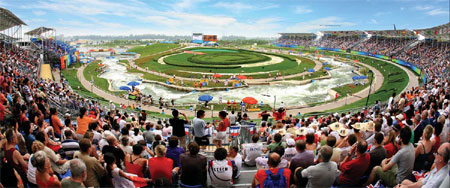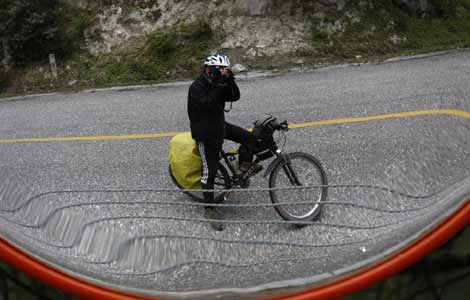Ready for the long haul
Updated: 2011-10-07 10:15
By Hu Haiyan (China Daily)
|
|||||||||
|
|
Shunyi Olympic Park hopes to become the destination of choice for water sports enthusiasts
After dazzling global audiences with its natural beauty and splendor during the 2008 Beijing Olympics, the Shunyi Olympic Rowing-Canoeing Park is now positioning itself as a top destination for water sports enthusiasts.
Though the park does occasionally host high-profile international water sporting events such as rowing and canoeing, the main focus is to attract the high-end and premium water sport enthusiasts, says Yang Fenghui, deputy director of the management committee of Beijing Shunyi Olympic venues.
Yang, who is also the deputy general manager of the investment and development center of the Shunyi Olympic Rowing-Canoeing Park, says the main challenge for his team is how to make optimal use of the park and its facilities while preserving its legacy.
To some extent, that explains the intense scrutiny and vetting process before the green light is given to events in the venue. Though some of the venues in the park are making a profit, the main task is for the entire park to be in the black, the 39-year-old Yang says.
"The Olympic park is a legacy of the 2008 Olympic Games. We started to make some profits last year and are confident that we can maintain annual growth rates in excess of 3 to 4 percent," he says without revealing the actual numbers.
Yang's confidence is such that he hopes the Shunyi park will be a listed entity and a landmark venue in the long run.
Spread over a planned area of 162.59 hectares and a floor area of 32,000 square meters, the Shunyi Olympic Rowing-Canoeing Park was the designated venue for the rowing, canoeing and marathon swimming events during the 2008 Beijing Olympic Games. It also hosted rowing events during the Beijing Paralympics later that year.
"The park was the largest newly-built Olympic venue in Beijing. It is known for its grandeur and panoramic view," says Yang.
What makes the venue really unique is its combination of slalom and flatwater facilities, the only one of its kind in the world today. The natural, green and waterside venue also packs within its spectacular natural beauty, forests, and beautiful lakes, making it an ideal location for athletes to optimize their performances.
"There is no exaggeration in saying that the site is an oxygen bar created by Mother Nature," Yang says.
The infrastructure surrounding the park has also grown in tandem with the area's development before and after the Olympics.
"The infrastructure here is something that everyone in Shunyi can be proud of", especially after the venue opened to the public in May 2009, Yang says.
The park was recently the venue for an international sailing competition involving teams from China, Japan and South Korea in September. In August of last year, the venue also hosted the famous Oxford-Cambridge rowing competition, a century-old race between the two universities.
"The international events have gone a long way in enhancing Shunyi Olympic Rowing-Canoeing Park's high-end image worldwide," says Gao Hong, general manager of the Beijing Sports Window Company, an institution that is involved in operation and management of sports venues.
At the same time, the park is now also an upscale leisure club for rowing, canoeing, water-skiing and diving enthusiasts. Top-notch business leaders, such as Sean Maloney, executive vice-president of chipmaker Intel, are members of the Shunyi rowing club.
"Shunyi is home to mature foreign communities and has several international schools and high-end villas. Most of the high-income expatriates live here, making it the best customer base for upscale leisure clubs," says Gao.
Though the opportunities are immense for further development, there are also several obstacles, admit experts.
"During my business trips abroad, I realized that Olympic venues across the world face several challenges to keep themselves in the black and be self-sustainable. No nation has also been able to make these venues money-spinners," says Yang.
"Though we spend huge amounts every year to maintain and preserve these venues and parks, the footfalls have never been satisfactory enough," he says.
Yang says that the Shunyi Olympic park has some shortcomings, such as inadequate catering and transport facilities, to sort out to stay sustainable in the long run.
"Good catering facilities are lacking, and this fact did not get due attention even during the construction stage. It has become a major hindrance for future expansion," says Yang.
Shunyi also suffers a major disadvantage, as the venues are not connected to any major subway line or bus route. Although it takes juts 30 minutes to reach Shunyi from downtown Beijing, the absence of direct travel facilities is a major impediment in attracting footfalls.
But with the city authorities planning a new subway line to connect Shunyi with Beijing, things may further improve.











